This fermented honey garlic is the perfect thing to make to boost your immune system! Both honey and garlic have strong medicinal benefits, so you’ll want to have this delicious home remedy on hand for cold and flu season.
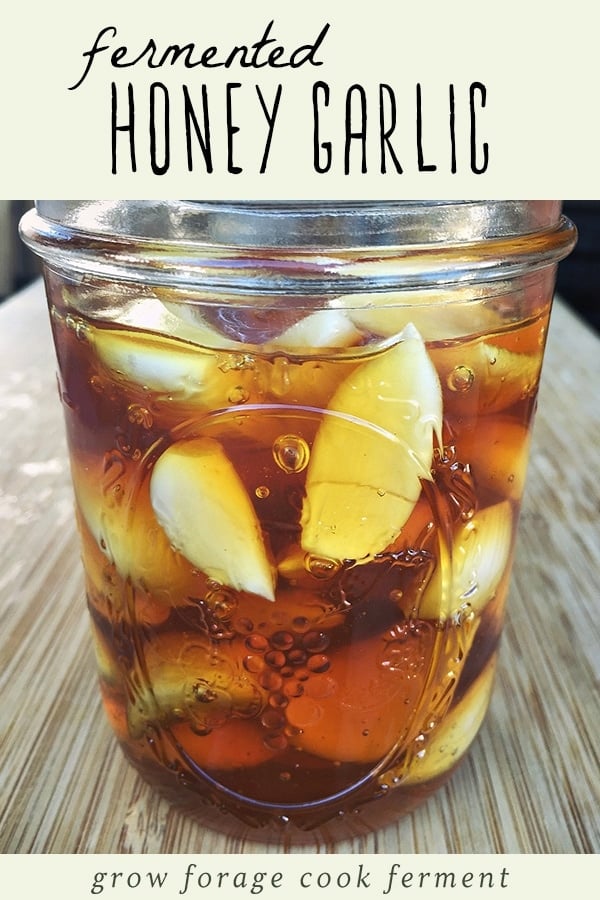
Want to save this post for later?
Fermenting Garlic in Honey
I’m really excited to share this post with you! Fermented honey garlic is something I’ve been wanting to try for a very long time, ever since I first read about it on the Killer Pickles blog.
I usually reserve my honey for mead making, but using it for other ferments intrigued me. Don’t ask me why I haven’t done it until now, because it’s the easiest thing in the world!
This tasty fermented garlic in honey can be used for many things, as good food and good medicine. Honestly though, I like to just eat it as is!
Fermented Honey Garlic Recipe
Making fermented honey garlic is so easy, it hardly needs a recipe!
Prepare the Garlic
The hardest and most time consuming part is prepping all of the garlic. Whatever size jar you use, you’ll want to fill it about 1/2-3/4 full of peeled garlic.
The quickest and easiest way to prep garlic is to place the side of a chef’s knife on top of a single clove and then give it a firm whack with the palm of your hand.
Don’t do it too hard, as you don’t want to crush the garlic, but just enough to lightly bruise the it. This will make it easy to peel, and will also release a bit of the garlic juice.
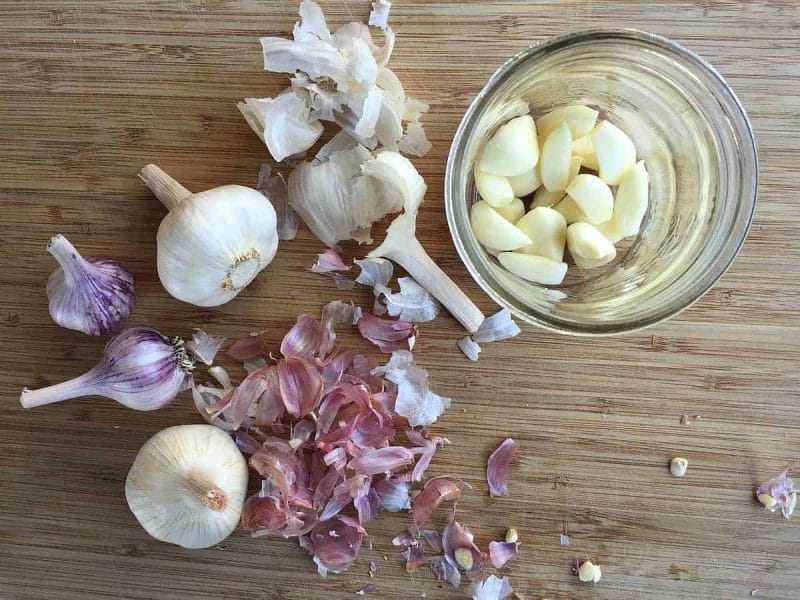
Add the Honey
Once you have enough garlic in your jar, pour in some raw honey to cover it. The garlic will probably float a bit and that’s ok.
It’s important to use raw honey to make fermented garlic in honey, as it will still have all the bacteria and wild yeast that is necessary for fermentation.
When liquid is added to honey, it jump starts the fermentation process. The small amount of juice from the garlic will create just enough liquid for fermentation to happen.
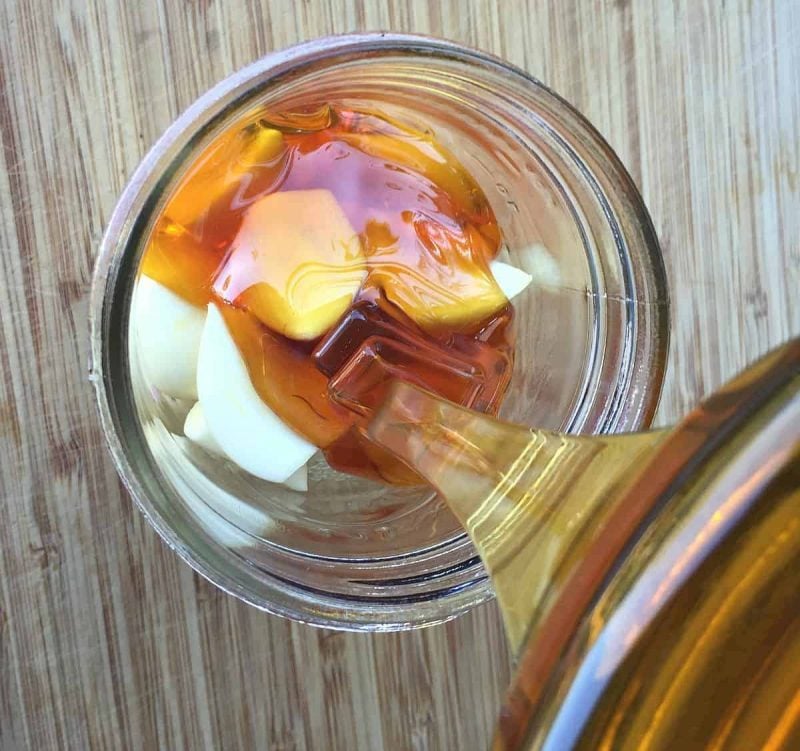
Cover and Flip
Cover the jar loosely with a lid to let the gasses escape, and put it in a dark place to ferment.
It’s a good idea to put a plate or something similar underneath the jar as it’s fermenting, as it will likely bubble up a bit and a little honey could possibly drip out.
It’s also important to gently turn the jar over every day or so, or whenever you think about it, to make sure that all of the garlic stay coated with honey.
Screw the lid on tightly before you do this! Then return it to it’s upright position and re-loosen the lid.
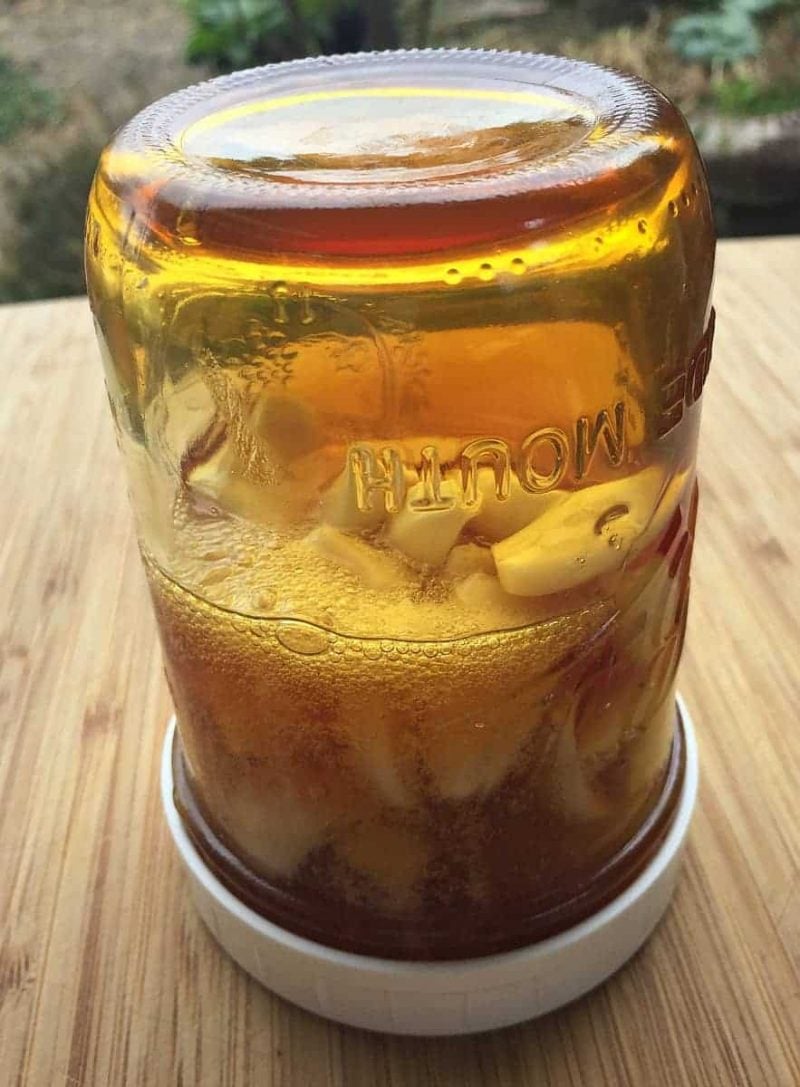
In a few days to a week you will notice some bubbles forming on the surface of the honey. Hooray!
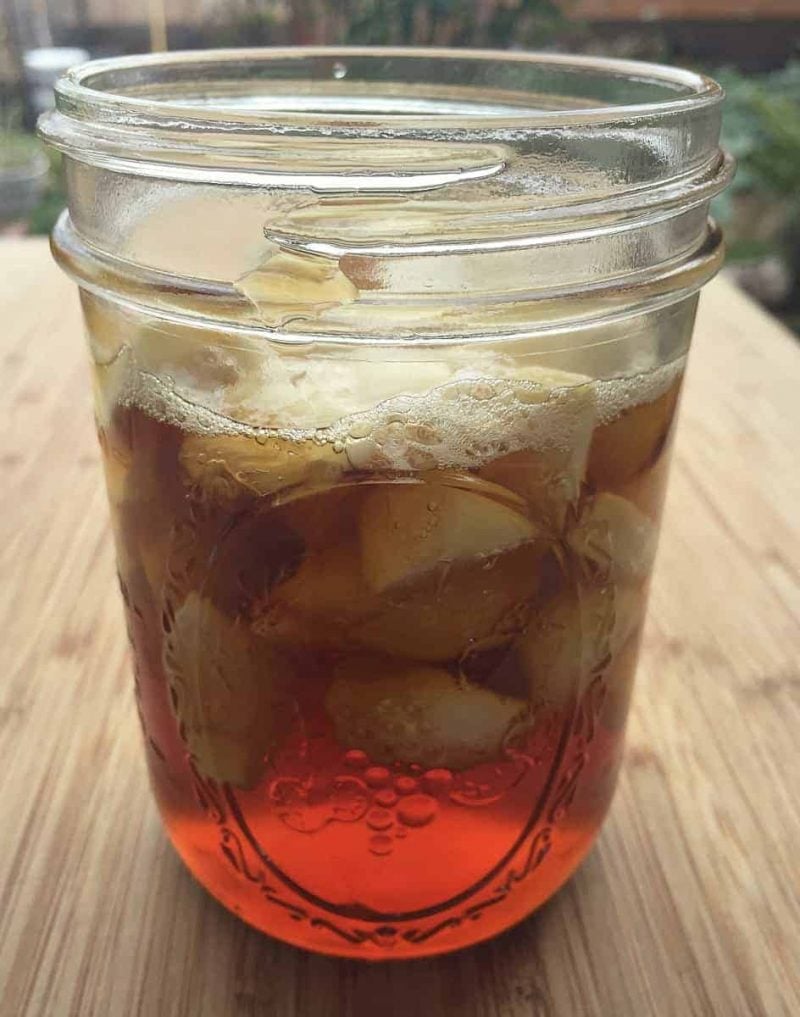
The honey garlic will ferment for about a month, but you can eat it at any time during the process.
The flavor will continue to develop over time, the garlic will mellow, and the honey will become much runnier.
Occasionally the garlic cloves turn a blue or green color due to a reaction during the fermentation process. While it may be a bit alarming, it is not harmful and the honey garlic can still be used.
Honey garlic will store well in a cool place for many months, or even a year or longer! I’ve kept some for over two years and it is still good.
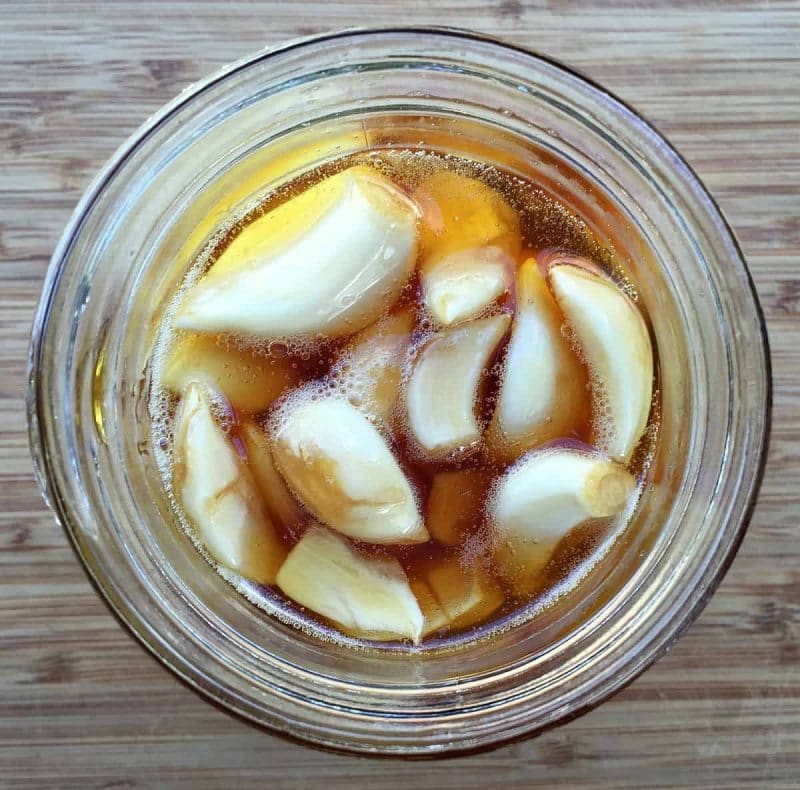
Using Fermented Honey Garlic
Now, how do you use this fermented honey garlic? That’s a good question, and it can be used in a variety of ways.
Both garlic and honey have strong medicinal properties, so it makes sense to use it as an immune booster or if you feel a cold or flu coming on.
Pop a whole garlic clove, or take a spoonful of honey (or both!).
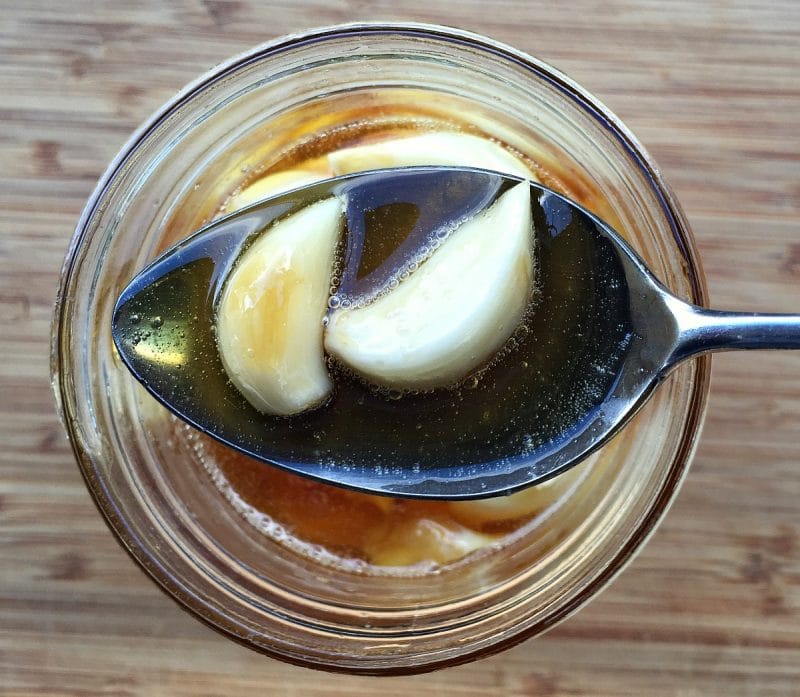
As you can probably imagine, honey garlic also makes a wonderful food!
It’s a natural in marinades and sauces, and would make a really tasty glaze for meats or veggies. Basically anything where you would normally use honey and garlic together!
Is Botulism a Concern in Honey Garlic?
I get this question a lot about fermented honey garlic! The short answer is no, botulism is really not a concern in this type of ferment.
While botulism can happen in garlic and oil preparations without added acidity, the fermentation process that happens here makes it very unlikely.
Raw honey is acidic, and while it can carry botulism spores (which is why it is not recommended for babies under 1 year), the level of acidity stops them from reproducing, which is what causes botulism.
If you are concerned about it, use a pH test strip. Botulism spores can’t reproduce with a pH of less than 4.6. Honey is usually around 3.9, but that can vary between brands.
If the pH is too high, add a splash of raw apple cider vinegar to add more acidity and retest. This is generally not needed, but I did want to mention it.
Honey garlic should not be given to babies under one year of age.
I really hope you make this yummy honeyed garlic! It’s super easy, and great to have on hand. I have a feeling it’s going to become a staple in our house!
Have you ever made fermented honey garlic? How do you use it?
More Fermented and Infused Honey Recipes
Enjoy these other recipes that showcase fermented and infused honey!
- Fermented Honey Cranberries
- Fermented Elderberry Honey
- Herbal Infused Honey
- Lilac Flower Infused Honey
Fermented Honey Garlic
Equipment
Ingredients
- 1 cup whole garlic cloves peeled and slightly crushed
- 1 cup raw honey or more, as needed to cover garlic
Instructions
- Place the peeled garlic cloves into a wide-mouth pint sized mason jar. Add enough honey to completely cover the garlic cloves. Make sure they are coated with honey.
- Place the lid on the jar loosely, then tuck into a dark place.
- Every day or so, tighten the lid on the jar and flip it upside down to coat the garlic cloves with honey. Loosen the lid again when you return it to the upright position.
- Within a few days to a week, you should see small bubbles start to form on the surface of the honey.
- The honey garlic will ferment for about a month, but you can eat it at any time. The flavor will continue to develop over time, the garlic will mellow, and the honey will become much runnier.
- Store in a cool place for many months or even a year, if not longer.
Notes
- It’s important to use raw honey for this recipe, as it has all of the bacteria and wild yeast that is necessary for fermentation.
- The small amount of juice from the garlic will create just enough liquid for fermentation to happen.
- It’s a good idea to put a plate underneath the jar during fermentation, as it will likely bubble up and a little bit of honey could possibly drip out.
- Occasionally the garlic cloves turn a bluish or greenish color during the fermentation process. While it may be a bit alarming, it is not harmful and the honey garlic can still be used.
- If you are concerned about botulism, use a pH test strip. Botulism spores can't reproduce with a pH of less than 4.6. Honey is usually around 3.9, but that can vary between brands.
- If the pH is too high, add a splash of raw apple cider vinegar to add more acidity and retest. This is generally not needed, but I do want to mention it.
- Honey garlic should not be given to babies under one year of age.

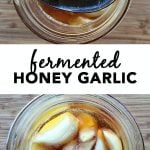
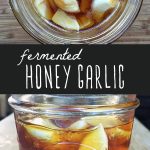
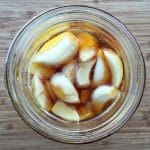

has anyone ever done this with creamed raw honey? i just did this tonight and i don’t think it will work lol. the honey is too thick. i’m wondering if the garlic will release enough liquid to make this work. uh oh !
Hi. Yes I am currently starting week 3 of my honey garlic fermentation process using raw unfiltered local honey. It was very thick at the beginning of course but after about 3 days to a week the honey separated and became very thin. It’s working great. Only thing I wonder is xan other things be added to make the antibiotic properties more powerful. Like I know oregano has antibiotic properties so can oregano be added to the fermentation process without negative affects?
Hi Joshua. Yes, you can definitely add other herbs to your garlic honey, however, I would either start a new batch with them, or remove a portion of your current batch to a new jar with the new ingredients, that way you don’t risk cross contamination to your mother batch.
I have some honey fermented garlic that I started about 2 weeks ago. It has thinned and had for a few days a thin line of bubbles around the top edge. That has pretty much stopped already. It does burp ever so slightly. Is this adequate fermentation or do I need to do something to help it along?
Yes, that sounds very normal for a honey ferment.
I made this last fall. Right after Christmas (and B4 we heard of COVID19) my adult son was very ill w/ a respiratory illness. I sent him a bottle of this and other supplements. He hated garlic and refused to use it till he was so sick and desperate. Five mo. later I received an injury, that turned into a fungal and bacterial mess! I needed to heal. He called me and told me to eat my garlic! We are believers in this stuff.
Is it healthy for TTC woman to eat raw garlic and still get pregnant?
Interested in giving this a try…can I use my burpee tops that I use when I ferment sauerkraut?
Yes, that is what I use. I also use jar weights to keep the garlic under the honey.
When using sprouted garlic do you take the green growth out before putting in the honey?
I made the honey garlic mix and let it ferment.
Now i wonder if it’s going bad… The cloves gave turned a bit darker.. Is that still okay?
They still smell garlicey but it seems a bit less strong then before. Maybe thats just the honey taking over all the propertys!?
I’ve made this in the past and when I wanted my batch to slow down fermenting, I started to store it in the refrigerator. I just recently finished a batch that was maybe 14 months old but in cold storage. The cloves get a little soft and the honey runnier. Cloves are darker and I have used them cooked but mostly raw with no issue. I say go forth and eat your candied garlic! Another note is that I usually crush the garlic a little bit before putting in jar.
I have had some going for over a month. I used it the other day to drizzle on pizza, but now there aren’t many bubbles. Is that a bad sign?
I just started mine, and added ginger, turmeric, and cinnamon. I can’t wait to see how this turns out.
Great idea, thx!
Ah that sounds nice! Fresh garlic and tumeric and then a cinnamon stick? Hmm!
Be careful using spices, some like cinnamon are anti bacterial and can interfere with the fermentation
Sure would like to hear back, how they turned out!
Dianne
How’d it turn out?
I am writing a feature for my podcast on fermented honey garlic and in my research, I have read that you have to choose other mix-in’s carefully. For example, it was said in one forum that cinnamon alters the fermentation and can open the door for problems. Sorry, I do not have the reference at hand but I do remember that it has an impact on the rate of fermentation in some way. The general premise is that ginger was fine but cinnamon was something you have to be careful with. Not trying to be an alarmist, just share an insight that I came across.
Can you melt the honey first to make it easier to work with
Yes. Heat up the jar of honey in warm/hot water for about 1-2 minutes. That’ll help it loosen up to be easier to work with.
Can people with diabetes 2 eat this honey & Garlic fermented mix?
Honey is moderately high on the glycemic index. For comparison’s sake, it’d be similar to eating a spoonful or so of honey straight. Even with the lacto-fermentation process “eating” the sugar and, as a result, producing CO2 and very small (virtually untraceable) amount of alcohol, the sugar content of the honey will be reduced, but only slightly. So you’ll need to take that into consideration when eating this product with any form of diabetes.
I’ve had my garlic in my honey for about a week now and there’s still no bubbling. I did use already peeled garlic from the grocery store and it had been frozen, could that be a factor? Should I discard this jar and start over with new honey and unpeeled garlic?
Don’t throw it away! I may nothave fermented the way you want, but it’ll still make a great natural cough medicine. Take a teaspoon full, to help relieve a cough.And it’ll still be a great immune booster,too. If you’re still looming to ferment, just start a new jar, Good luck!
Unfortunately, the you’ve used a low quality garlic, which certainly won’t have helped. You want the freshest, best quality garlic you can get your hands on, think Organic farmers market.
If it didn’t ferment, chances are you’ve not used a good quality, raw honey. Most commercial honeys are pastuerised, which kills allt he good bacteria, including the wild Yeast that you need to ferment the garlic.
Start again with good quality ingredients and a very clean jar, I’m sure it will work better next time. Good luck!
Was the garlic whole it needs to be crushed or sliced in half
Whole garlic is what I’ve used for 12yrs
Wonder if they’re from China, my understanding is most bleach their garlic before shipping.
Dianne
Does it give you “garlic breath”?
Hello Linda from the netherlands here 😊!
I have a question? What you mean with the kind of honey I need to just?
I can’t just by honey in the store? I have to by it wit a bee inker ?
Isn’t that very expensive? Can I also just just honey from the supermarket?
Lots of love Linda 💋
Hi Linda! Raw honey is best, but any honey will work!
Very good point! Nothing actually stops it, but the cool temp of the fridge slows it down adequately.
I have made raw garlic with raw honey and I cut the garlic in small pieces.is that still ok
Hi, Linda! I don’t know abt. where you live, but here in Pa, in the Usa. It’s actually cheaper to buy directly from the beekeeper. Cut out the middleman, and go straight to the source, I always say. Besides local honey is always the best, for medicinal uses. Here in the state’s we have Farmers Markets everywhere,its a great place to get local honey, if you don’t know a beekeeper, yourself
Can i store in fridge after initial fermentation? The cool spots in my house are “out of sight, out of mind”……
Thanks, love your book.
What stops the fermentation process? It says “ferment for a month then store at room temperature.” Won’t it continue to ferment? What’s the difference between ” ferment” and “store”?
Can you use pre peeled garlic from someplace like Costco?
stay away from garlic from China, I do not know where the garlic from Costco is from. If it doesn’t say, then it is probably from China where it is grown in polluted ground, even the organic. I have read that garlic from Mexico is often China grown.
Could I chop my fresh garlic so that it would be sort of like a relish? I’m thinking that it would be a good marinade as well.
TIA
what to do..i have a 5 gallon bottle of honey that is either crystallizing or fermenting. What can I make that keeps a while…6 months to Xmas?
Hi Cindy, sounds like you need to make some mead! That’s usually what I do when my honey starts to crystallize. Here is my basic recipe: How to Make a Gallon of Mead
You can just warm it up to dissolve the crystals and use it. Honey doesn’t really go bad. I like it when it is a bit old; the flavor is more complex.
Honey doesn’t go bad. Real honey crystalizes. You just need to gently warm the jar in a pot of water to liquify it. If you just need some for tea simply use a spoon and scoop it out and stir it in your hot tea.
I made a jar of honey and crushed garlic to ferment two days ago…and on reading up on the topic further- I learnt about botulism. But after doing further research on it, I found out that even though both honey and garlic usually contain the bacteria spores….the danger only exists when the spores become active and release toxins…which it can only do under specific conditions. 1) low oxygen 2) ambient temperatures 3) ph above 4.6, 4) low salt 5) protein source 6) low sugar environment. Honey ferments are definitely high sugar environments and after fermentation begins, it eventually becomes a highly acid (low ph) environment, so no need to worry about botulism….even though the bacteria is most likely present, it cannot release toxins in such a high sugar AND high acid (after fermentation) environment. Pheww….
Do you have any documentation about this?
My understanding is that the original recipe for fermented honey garlic comes from ancient Egypt and that archaeologists found some in Egyptian tombs and sampled it, and found it to be really yummy. Here is an article from National Geographic describing how honey never goes bad and why. Sadly, I’ve not been able to re-find the article about the fermented honey garlic, but it has been referenced in several vlogs.
https://www.nationalgeographic.com.au/history/honey-in-the-pyramids.aspx
I make lacto-fermented veggies, and often give each batch a jump start with probiotic-rich brine from a previous batch. Could I use just a splash of kraut brine to get things rolling with the honey?
It is really interesting to see fermented garlic. Last days i am thinking to ferment Garlic. But when it is finished it will be black. Do you know about black garlic? Could you help me how to do? Thanks for Your valuable knowledge…
Black garlic and honey fermented garlic are different. It’s worth making both–they’re distinct. I made a pot of beans recently and added both types (plus regular raw garlic, plus onion, plus cumin)…very tasty. One source: https://www.youtube.com/watch?v=bF39Xet-3Nk
I’m very excited! My gateway ferment was green beans last Fall. I’ve worked my way through fermented hot sauce during the holidays, several gallons of kombucha a month, sauerkraut, and am starting to forage!
I’m going to try your garlic honey ferment plain and with Thyme. My plan is to create a charcuterie platter with the honey garlic, pickled magnolia flowers(some sweet/sour and some with Sanaam peppers), fermented bitter cress(land cress) and a wild violet creation.
I love be your site. I can’t tell you how much you’ve helped me eliminate gluten, dairy, and cane sugar from my diet. Thank you for providing alternatives and ideas for my new diet!
I have had garlic and raw honey in a jar for about three months now. I never noticed any bubbling. Any potential problems ?
Same here!! I have had my honey and garlic in a jar for almost a month. No bubbling. Why? Is it okay to use it or do I throw it away?
Hi! I’d love to try this. Which specific garlic do you use?
When would you add the Apple cider vinegar. I just want to add it for a precaution.
What if I eat it after a year? 2 years? 3 years? And so on…
Hi, can I add anything else to the jar, such as peppers or pepper flakes before the fermentation process?
Yes you can!
1 of my garlic cloves started to turn burn/greenish after about a week. I’ve thrown the clove out but is the rest of the batch still ok to eat?
Green is not bad. There’s a chemical reaction in fermenting garlic that often causes it to turn blue/green. It does not affect flavor and is totally safe to eat. Here’s an article from spruceeats on the subject: https://www.thespruceeats.com/garlic-turns-blue-when-pickled-1327752
Once it’s been fermented, how do you add to it? Can you add more garlic and honey to an already fermented batch or do you have to start from the beginning again?
It’s best to start from the beginning again, as adding to it can change the pH negatively.
I’ve fermented a lot of different food and drinks but have heard that honey garlic is one of the few where there is a risk of botulism. Is this true? My PH meter doesn’t seem to get good readings in the honey. Makes me nervous, should I be?
You really don’t need to worry about it with this type of ferment. Honey has a low enough pH that botulism isn’t an issue. If you are worried you can always add a splash of vinegar to make it even more acidic.
I’m sorry, but this is absolutely not true. It is known that honey (raw or not) may contain clostridium botulism which is why it is NEVER recommended to give to children under 2yo, immunocompromised, or pregnancy. While it is unlikely an adult with a healthy immune system would be infected, there is ALWAYS a risk of botulism with honey. Making sure the ferment brings the pH down below at least 4.6 will render it safe from botulism.
Hi Jane, I wasn’t speaking of the inherent risk of giving honey to young children (which is only dangerous for those under one year of age, not 2… and on that note, honey is perfectly safe for pregnant women as well). What people are concerned with here is that adding the garlic to honey could possibly release botulism toxins due to a low oxygen environment (such as adding garlic to oil without any acid, which is a totally valid concern). But, the pH of honey is such that it just wouldn’t happen, especially after fermentation, and it is also high in sugar which the botulism toxin can’t thrive in (*not the botulism spores which is what the honey concern is with babies – they are two different things).
I just found some garlic that got misplaced in the back of a cabinet. It has started sprouting! Can I still use for this or should I just chuck it and buy new?
Yes,
you can use garlic that has started to sprout. We grow our own garlic and I use mine all the time.
“Sprouted garlic enhances raw garlic’s proven anti-inflammatory, immune-boosting, cardiovascular health protection, and its ability to kill 14 types of cancer cells. A sulfur-rich compound in garlic called allicin is effective against bacteria, viruses, fungi, and parasites without toxic side effects.”
Is that a quote from somewhere? If so, from where? It sounds like an informative book/site.
This is good to hear, as I’ve heard the opposite. I prefer to believe this!!